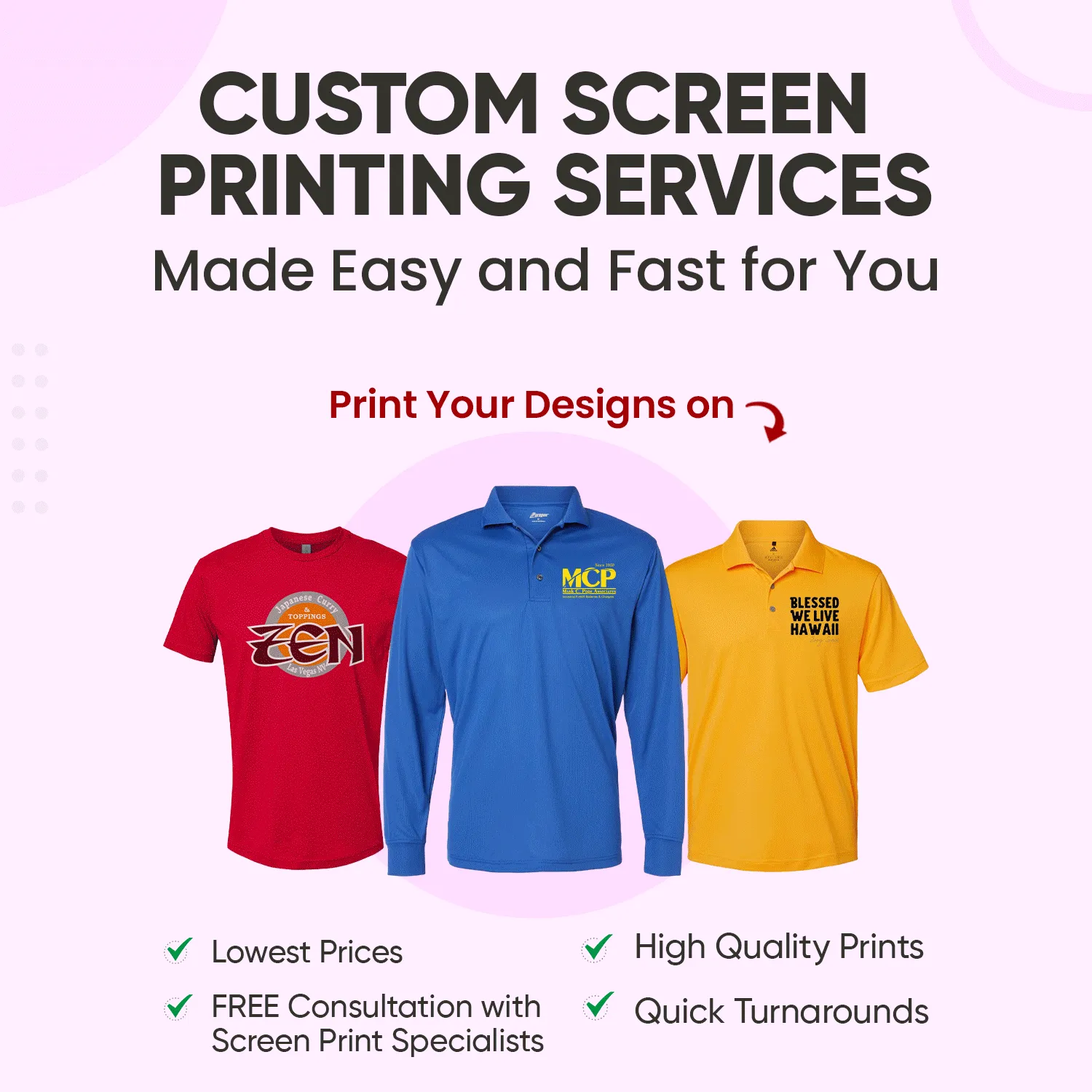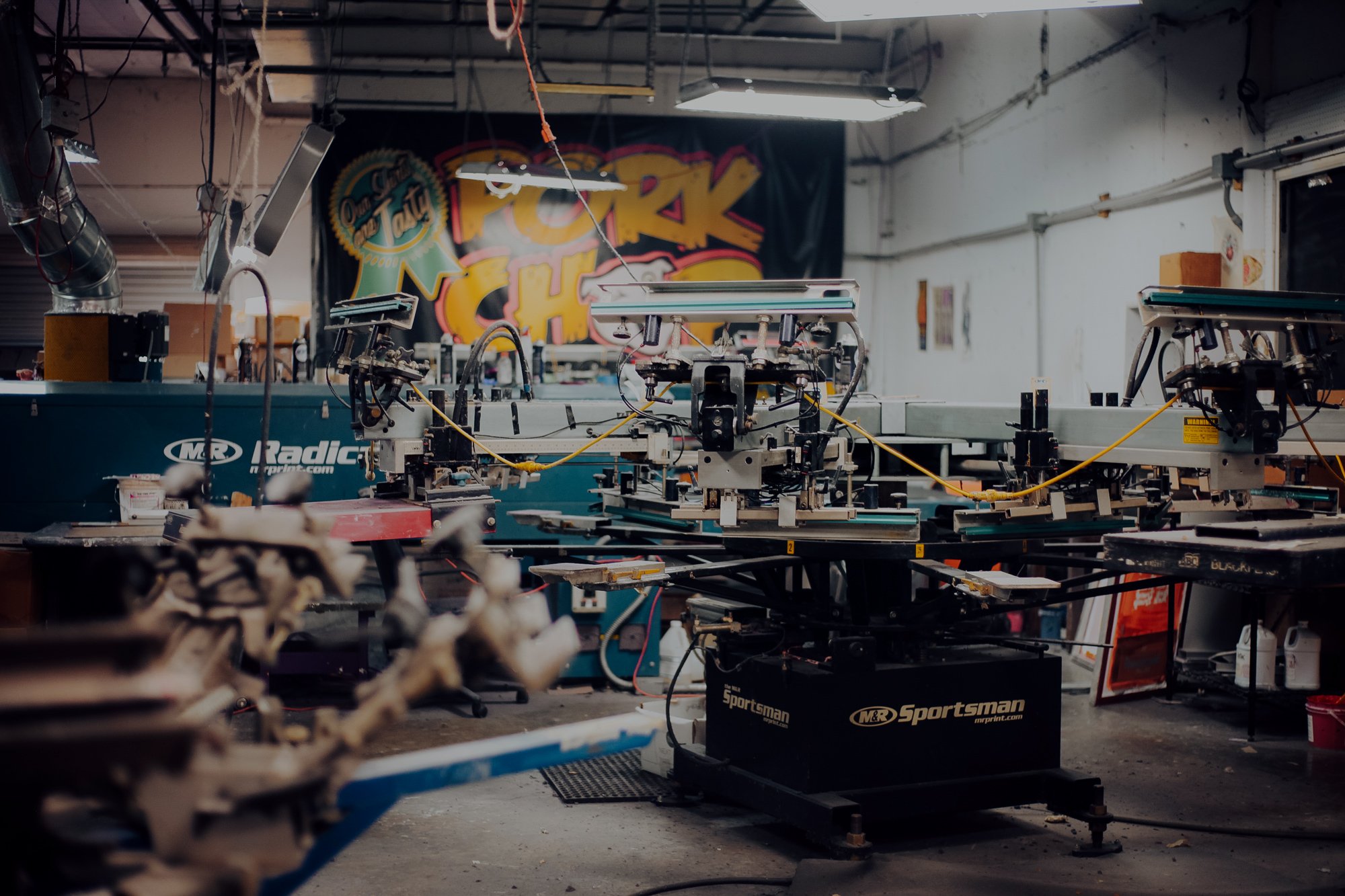The Ultimate Display Printing Kit: Crucial Tools for Effective Garment Printing
When it involves evaluate printing, having the right devices can make all the distinction. Your package must consist of fundamentals like a tough structure, a dependable squeegee, and a top quality exposure system. But what concerning the inks and displays? Choosing the best products tailored to your certain tasks is important. You'll quickly uncover how these elements function with each other to elevate your printing video game. Allow's explore what each tool gives the table and just how to optimize their capacity.
Understanding Screen Printing Basics
When you engage yourself in display printing, you'll discover it's both a science and an art. Once dried, you expose the screen to UV light with your design placed on top, permitting you to develop a stencil.
Next, you'll set up your printing station, aligning your display with the garment. Making use of a squeegee, you'll press the ink via the display, making certain also insurance coverage. The elegance of display printing exists in its flexibility; whether you're printing intricate patterns or vibrant graphics, the procedure stays the exact same.
As you technique, you'll find out about ink types, drying times, and shade mixing. Each print is a possibility to refine your technique and express your creative thinking, making display printing a gratifying endeavor for any person enthusiastic about design.
Important Components of the Display Printing Set
To start with screen printing, you require to understand the important parts of your set. You'll intend to acquaint yourself with the standard devices, the kinds of inks and solutions you'll make use of, and the tools for application. Each component plays a crucial role in attaining premium prints on your garments.
Basic Tools Summary
A fully equipped display printing kit is vital for any individual looking to develop spectacular garment layouts. Begin with a tough screen printing structure, which holds your mesh firmly for specific printing. You'll likewise require a squeegee to push ink with the mesh onto your fabric. Do not forget the exposure device or light source, essential for transferring your layout onto the screen. A washout station aids you clean screens after usage, ensuring they await your following job. Lastly, spend in a registration system to align several colors accurately. With these crucial components, you'll have a solid structure for your screen printing journey and can concentrate on bringing your imaginative visions to life.
Inks and Solutions
After gathering the basic tools, your following focus needs to be on solutions and inks, which play an essential role in accomplishing dynamic and resilient prints. When picking inks, consider water-based, plastisol, or discharge inks based upon the textile kind and desired finish. Water-based inks are soft and environment-friendly on garments, while plastisol supplies toughness and intense shades.
Emulsions, on the other hand, are crucial for creating your screens. They assist establish the pattern needed for printing - custom screen printing. You'll intend to select a top notch solution that suits your ink kind and direct exposure approach. Bear in mind to keep inks and solutions correctly to keep their effectiveness. With the appropriate selections, you'll establish the structure for spectacular, professional-grade prints.
Tools for Application

Choosing the Right Screens for Your Tasks
When you're picking screens for your jobs, the mesh count and structure product are necessary aspects to take into consideration. A greater mesh count is terrific for fine details, while the right structure material can boost resilience and stability. Understanding these components will certainly assist you attain the very best cause your display printing undertakings.
Display Mesh Count
Picking the best screen mesh count is vital to achieving the preferred outcomes in your screen printing tasks. The mesh matter describes the number of strings per inch in the screen, influencing just how much ink obtains moved onto your garment. For detailed styles and fine lines, choose a higher mesh matter, usually in between 200 and 305. If you're dealing with thicker inks or strong layouts, a lower mesh count, around 110 to 160, will function better. Always think about the sort of ink and fabric you're making use of, as these variables influence the mesh count selection. Exploring with various counts can assist you locate the best balance for your details tasks, making sure crisp, vivid prints every single time.
Frame Material Options
The display framework material you pick plays a considerable function in the high quality of your prints. They provide excellent stress, making sure crisp prints. Ultimately, select a product that suits your workflow and spending plan while ensuring your prints come out looking specialist and sharp.
Choosing Inks for Different Fabrics
Just how do you ensure your screen printing styles look last and vibrant on numerous materials? Picking the ideal ink is key. For cotton, water-based inks are your ideal bet. They saturate into the textile, supplying a soft feel and superb longevity. Consider making use of plastisol inks if you're printing on polyester or artificial blends. They sit on top of the material, assuring brilliant shades and great attachment. next
Don't ignore specialty inks like discharge or metallic inks. Release inks can remove dye from material, leaving a soft print, while metal inks add a shiny coating that stands out. Always check your inks on the specific fabric prior to committing to a large run; this aids you determine shade vibrancy and resilience.
Lastly, remember the fabric's weight and texture. Choosing the right ink for every textile type will ensure that your designs not just look excellent but likewise withstand the test of time.
The Relevance of Mops in Printing
Squeegees play an integral role in accomplishing premium prints in screen printing. They're your main device for transferring ink with the stencil onto the fabric, and the ideal squeegee can make all the distinction. When you apply regular stress with a squeegee, you assure an even circulation of ink, reducing the possibilities of irregular or blotchy prints.
Selecting the best durometer or firmness of your squeegee is important, as it impacts how much ink is drawn via the mesh. A softer squeegee is fantastic for in-depth layouts, while a firmer one functions well for vibrant graphics. In addition, the width of the squeegee should match your screen dimension to maximize your printing process.
Taking some time to understand your strategy with the squeegee will certainly result in cleaner, sharper prints. So, do not undervalue this integral device-- learn more about it, and you'll boost your display printing game.
Preparing Your Art Work and Emulsion
Accomplishing great prints begins long before you select up your squeegee. When you're satisfied with the layout, print it on transparency film, maintaining in mind that the darker the image, the much better it obstructs light during exposure.
Following, select the ideal emulsion for your project. Apply it equally to your screen in a dimly lit location to stop premature direct exposure. Allow it to completely dry completely, preferably in a dark area, to guarantee excellent results. When your display is prepared, reveal it to UV light according to your emulsion's directions. The light will solidify the solution where it strikes, leaving your design unexposed.
After rinsing the unexposed emulsion, let the screen dry totally. With your art work and emulsion ready, you're set for the printing process!
Maintenance Tips for Resilient Devices
Although it could appear tedious, routine maintenance of your screen printing tools can considerably prolong their life-span and warranty regular outcomes. Start by cleansing your displays instantly after use. Use a mild solvent to remove ink residue; this helps prevent build-up that can wreck future prints. Shop your displays level to prevent warping, and keep them away from straight sunshine. custom screen printing.
For mops, wipe the blade after each use to my latest blog post protect against ink from drying out on it. Consistently look for nicks or damages and change them as needed. Do not neglect your exposure device-- tidy the glass surface routinely to validate excellent light direct exposure.

Often Asked Inquiries
Can I Screen Print on Dark Colored Fabrics?
Yes, you can screen print on dark tinted materials! Simply make use of an appropriate opaque ink developed for dark products.
Just how Do I Tidy My Displays After Printing?
To clean your screens after printing, you'll need a pressure washer or hose pipe to remove excess ink. Make use of a display cleaner or light cleaning agent with a soft brush to scrub away residue. Rinse completely.
What Safety and security Gear Do I Need While Display Printing?
When display printing, you'll need gloves to protect your hands, a mask to avoid breathing in fumes, and safety and security goggles to secure your eyes from chemicals and inks. Being cautious guarantees a safe and enjoyable experience.
Can I Make Use Of the Package for Various Other Products Besides Material?
Yes, you can use the kit for other materials besides fabric. It functions well on surface areas like wood, plastic, and paper. Simply make certain the ink and methods match the material you choose.
How Lengthy Does It Take for Ink to Cure?
Ink generally takes about 24-hour to heal completely, but it can vary based on the type and density. You'll wish to check the manufacturer's standards for certain curing times to assure excellent outcomes.
Using a squeegee, you'll press the ink via the screen, making sure also protection. You'll require a dependable squeegee, which aids uniformly disperse ink across your display.Selecting the right display mesh matter is necessary to accomplishing the wanted results in your display printing jobs. The mesh matter refers to the number of threads per inch in the display, impacting how much ink obtains transferred onto your garment.To cleanse your screens after printing, you'll require a stress washer or tube to eliminate excess ink.